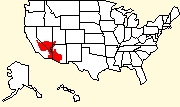|
Mojave Desert Sidewinder
VENOMOUS
|
- Order: Squamata (scaled reptiles)
- Suborder: Serpentes (=Ophidia) (snakes)
- Family: Viperidae (vipers)
- Subfamily: Crotalinae (rattlesnakes)
- Genus: Crotalus (rattlesnakes)
|
| Also Known As: Mohave
desert sidewinder, horned rattler |
Scientific Name: Crotalus cerastes
cerastes Hallowell, 1854 |
| Habitat: Desert flats,
sandy areas, dry washes. |
Krotalon="rattle," kerastes="horned"
|
| Length: 32+ inches. |
|
| Food: Rodents and
lizards. |
 |
| This is one of my prize finds. I
found this snake on my last drive of my August 1999 trip, on a
side road a mile east of the Great Basin Highway in Nevada. There
was a full moon that night and it was not raining. It was amazing
to watch this rattlesnake move sideways as I chased it around the
road; I got some great video of it. The first picture shows the
snake coiled in a defensive posture. Please note that the snake's
initial response to me was to flee. Only after I had run around in
circles to keep the snake on the road and in sight (its pattern
blended perfectly with the gravel on the roadside), after the
snake tired, did it assume this position. The picture makes the
sidewinder look bigger than it is--it's maybe 15 inches long at
most. Almost all the rattlesnake species found in the American
Southwest are under 3 feet long full-grown. |
 |
| The second picture is not
something you'd want to see face-to-face. The sidewinder's face is
right up against the camera lens, that's why the outline is out of
focus. To get this view I held the camera down in front of the
snake. Notice that this is not a strike--the snake's mouth isn't
open. I think the video camera confused the snake more than
frightened it. All it did was get close to the lens and stick out
its tongue to test the air. The snake never struck at me the whole
time, but rattled constantly. I finally chased it off the road. |
 |
| This next beautiful sidewinder
was found warming itself on the road in Valley of Fire State Park
around 10:30 p.m. PDT in April 2000. It is estimated to be about
30 inches long, which is large for a sidewinder. Sidewinders, like
all rattlesnakes, are venomous and should not be approached,
especially if you're drunk! Many snakebites occur with
intoxication as a contributing factor, and it's not the snakes
doing the drinking! |
 |
| As with the last sidewinder I
found, this one made no attempt to strike. In fact, when I first
touched it, it hardly even moved. These snakes would rather flee
than attack a predator, and would rather save their venom for
killing their prey. After taking a few minutes of video, this
sidewinder was prodded off the road. I'm sure it returned to the
warm road surface after we left. Hopefully it wasn't hit by a
careless (or just mean) driver.
See also the sidewinders I found in California.
|
 |
|
|
|